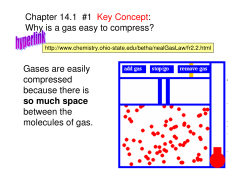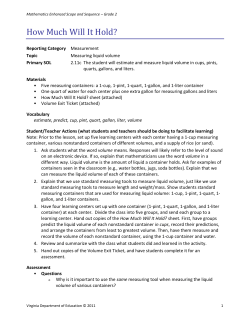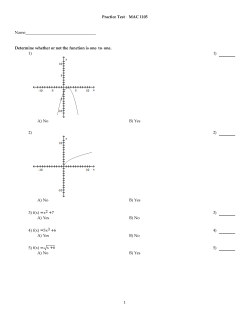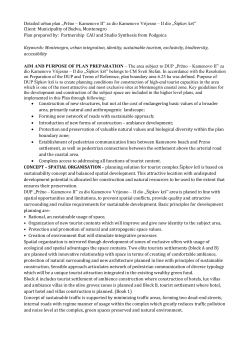
Chapter 5 Relations and Functions Yen-Liang Chen Dept of Information Management
Chapter 5 Relations and Functions
Yen-Liang Chen
Dept of Information Management
National Central University
5.1. Cartesian products and
relations
Definition 5.1. The Cartesian product of A
and B is denoted by AB and equals {(a,
b)aA and bB}. The elements of AB are
ordered pairs. The elements of A1A2…An
are ordered n-tuples.
AB=AB
Ex 5.1. A={2, 3, 4}, B={4, 5}.
What are AB, BA, B2 and B3?
Ex 5.2, What are RR, R+R+ and R3?
Tree diagrams for the Cartesian product
Relations
Definition 5.2. Any subsets of AB is called
a relation from A to B. Any subset of AA is
called a binary relation on A.
Ex 5.5. The following are some of relations
from A={2,3,4} to B={4,5}: (a) , (b) {(2,
4)}, (c) {(2, 4), (2, 5)}, (d) {(2, 4), (3, 4),
(4, 4)}, (e) {(2, 4), (3, 4), (4, 5)}, (f) AB.
For finite sets A and B with A=m and B=n,
there are 2mn relations from A to B. There
are also 2mn relations from B to A.
Examples
Ex 5.6. R is the subset relation where
(C, D)R if and only if C, DB and
CD.
Ex 5.7. We may define R on set A as
{(x, y)xy}.
Ex 5.8. Let R be the subset of NN
where R={(m, n)n=7m}
For any set A, A=. Likewise, A
=.
Theorem 5.1.
A(BC)=(AB)(AC)
A(BC)=(AB)(AC)
(AB)C=(AC)(BC)
(AB)C=(AC)(BC)
Why?
5.2. Functions: Plain and one-toone
Definition 5.3. f: AB, A is called domain and B is
codomain. f(A) is called the range of f.
For (a, b)f, b is called image of a under f whereas a
is a pre-image of b.
Ex 5.10.
Greatest integer function, floor function
Ceiling function
Truncate function
Row-major order mapping function
Ex 5.12. a sequence of real numbers r1, r2,… can be
thought of as a function f: Z+R and a sequence of
integers can be thought of as f: Z+Z
properties
For finite sets A and B with A=m and B=n,
there are nm functions from A to B.
Definition 5.5. f: AB, is one-to-one or
injective, if each element of B appears at
most once as the image of an element of A.
If so, we must have AB. Stated in
another way, f: AB, is one-to-one if and
only if for all a1, a2A, f(a1)=f(a2) a1=a2.
Ex 5.13. f(x)=3x+7 for xR is one-to-one.
But g(x)=x4-x is not. (Why?)
Number of one-to-one functions
Ex 5.14. A={1, 2, 3}, B={1, 2, 3, 4,
5}, there are 215 relations from A to B
and 53 functions from A to B.
In the above example, we have P(5, 3)
one-to-one functions.
Given finite sets A and B with A=m
and B=n, there are P(n, m) one-toone functions from A to B.
Theorem 5.2.
Let f: AB with A1, A2A. Then
(a) f(A1A2)=f(A1)f(A2),
(b) f(A1A2)f(A1)f(A2),
(c) f(A1A2)=f(A1)f(A2) when f is one-toone.
A1={2,3,4}, A2={3,4,5}
f(2)=b, f(3)=a, f(4)=a, f(5)=b
Restriction and Extension
Definition 5.7. If f: AB and A1A, then fA1: AB is
called the restriction of f to A1 if fA1(a)=f(a) for all
aA1.
Definition 5.8. Let A1A and f: A1B. If g: AB and
g(a)=f(a) for all aA1, then we call g an extension of f
to A.
Ex 5.17.Let f: AR be defined by {(1, 10), (2, 13), (3,
16), (4, 19), (5, 22)}. Let g: QR where g(q)= 3q+7
for all qQ. Let h: RR where h(r)= 3r+7 for all rR.
g is an extension of f, f is the restriction of g
h is an extension of f, f is the restriction of h
h is an extension of g, g is the restriction of h
Ex 5.18. g and f are shown in Fig 5.5. f is an
extension of g.
5.3. Onto Functions: Stirling
numbers of the second kind
Definition 5.9. f: AB, is onto, or surjective, if
f(A)=B-that is, for all bB there is at least one aA
with f(a)=B. If so, we must have AB.
Ex 5.19. The function f: RR defined by f(x)=x3 is an
onto function. But the function g: RR defined by
f(x)=x2 is not an onto function.
Ex 5.20. The function f: ZZ defined by f(x)=3x+1 is
not an onto function. But the function g: QQ defined
by g(x)=3x+1 is an onto function. The function h:
RR defined by h(x)=3x+1 is an onto function.
The number of onto functions
Ex 5.22. If A={x, y, z} and B={1,2}, there
are 23-2=6 onto functions. In general, if
A=m and B=2, then there are 2m-2
onto functions.
Ex 5.23. If A={w, x, y, x} and B={1,2, 3}.
There are C(3, 3)34 functions from A to B.
Consider subset B of size 2, such as {1, 2}, {1,
3}, {2, 3}, there are C(3, 2)24 functions from A
to B.
Consider subset B of size 1, such as {1}, {3},
{2}, there are C(3, 1)14 functions from A to B.
Totally, there are C(3, 3)34- C(3, 2)24+ C(3,
1)14 onto functions from A to B.
The number of onto functions
For finite sets A and B with A=m and
B=n, the number of onto functions is:
n m n
n
m
m
n 1 n m
n
(n 1)
(n 2) ... (1) 1
n
n 1
n 2
1
n
(n k ) m
(1)
k 0
n k
n
k
Examples
Ex 5.24. Let A={1, 2, 3, 4, 5, 6, 7} and B={w, x, y,
z}. So, m=7 and n=4. There are 8400 onto functions.
C(4, 4)47-C(4, 3)37+C(4, 2)27-C(4, 1)17=8400
Ex 5.26. Let A={a, b, c, d} and B={1, 2, 3}. So, m=4
and n=3. There are 36 onto functions, or equivalently,
36 ways to distribute four distinct objects into three
distinguishable containers, with no container empty.
For mn, the number of ways to distribute m distinct
objects into n numbered containers with no container
left empty is :
n
m
(
1
)
(
n
k
)
n k
k 0
n
k
Distinguishable and identical
distribute m distinct (identical) objects into
n numbered (identical) containers
{a, b} in container 1, {c} in container 2, {d} in
container 3
{a, b} in one container, {c} in the other
container, {d} in another container
2 objects in container 1, 1 object in container 2,
1 object in container 3
2 objects in one container, 1 object in the other
container, 1 object in another container
Stirling number of the second kind
The stirling number of the second
kind is the number of ways to
distribute m distinct objects into n
identical containers, with no container
left empty, denoted S(m,n), which is
1 n
k n
m
(
1
)
(
n
k
)
n k
n! k 0
n
S ( m, i )
i 1
It is the number of possible ways to
distribute m distinct objects into n identical
containers with empty containers allowed.
Theorem 5.3.
S(m+1, n)=S(m, n-1) + n S(m, n).
am+1 is in a container by itself. Objects
a1, a2, …, am will be distributed to the
first n-1 containers, with none left empty.
am+1 is in the same container as another
object. Objects a1, a2, …, am will be
distributed to the n containers, with
none left empty.
Ex 5.28.
30030=23571113. How many ways
can we factorize the number into two
factors? The answer is S(6, 2)=31.
How many ways can we factorize the
number into three factors? The answer is
S(6, 3)=90.
If we want at least two factors in each of
these unordered
factorization, then there
6
are 202= S (6, i )
i2
5.4. Special functions
Definition 5.10. f: AAB is called a binary
operation. If BA, then it is closed on A.
Definition 5.11. A function g:AA is called
unary, or monary, operation on A.
Ex:
the function f: ZZZ, defined by f(a, b)=a-b, is
a closed binary operation.
The function g: Z+Z+Z, defined by g(a, b)=ab, is a binary operation on Z+, but it is not
closed.
The function h: R+R+, defined by h(a)=1/a, is
a unary operation.
Commutative and associative
Definition 5.12. f is commutative if f(a,
b)= f(b, a) for all a, b.
When BA, f is said to be associative
if for all a, b, c we have f(f(a, b),
c)=f(a, f(b, c))
Commutative and associative
Ex 5.32.
The function f: ZZZ, defined by f(a, b) = a+b-3ab
is commutative and associative.
The function f: ZZZ, defined by h(a, b) = ab is
not commutative but is associative.
Ex 5.33. Assume A={a, b, c, d} and f: AAA. There
are 416 closed binary operations on A. Determine the
number of commutative and closed operations g.
there are four choices for g(a, a), g(b, b), g(c, c) and
g(d, d).
The other 12 ordered pairs can be classified into 6
groups because of the commutative property.
The total number of binary and commutative
operations is 4446.
Identity
Definition 5.13. Let f: AAB be a
binary operation on A. An element x
in A is called an identity for f if f(a,
x)= f(x, a)=a for all a in A.
Ex 5.34.
If f(a, b)=a+b, then 0 is the identity.
If f(a, b)=ab, then 1 is the identity.
If f(a, b)=a-b, then there is no identity.
Identity
Theorem 5.4. Let f: AAB be a binary operation on A.
If f has an identity, then that identity is unique.
Ex 5.35. If A={x, a, b, c, d}, how many closed binary
operations on A have x as the identity?
Because x is the identity, we have Table 5.2, where
there are 16 cells left unfilled.
There are 516 closed binary operations on A, where x
is the identity.
Of these, 510=5456 are commutative.
If every element can be used as the identity, we have
511 closed binary operations that are commutative.
Projection
Definition 5.14. if DAB, then A: DA,
defined by A(a, b)=a is called the
projection on the first coordinate. The
function B: DB, defined by B(a, b)=b is
called the projection on the second
coordinate.
if DA1 A2…An, then A: DAi Ai
Ai ,,,, Ai , defined by (a1, a2, …, an)= ai ,
ai , ai , …, ai is called the projection on the
i1, i2, …, im coordinates.
1
3
2
m
3
2
1
m
The projection of a database
5.5. Pigeonhole principle
The pigeonhole principle: If m pigeons occupy n
pigeonholes and m>n, then at least one pigeonhole
has two or pigeons roosting in it.
Ex 5.39: among 13 people, at least two of them have
birthdays during the same month.
Ex 5.40. In a laundry bag, there are 12 pairs of socks.
Drawing the socks from the bag randomly, we will
draw at most 13 of them to get a matched pair.
Ex 5.42. Let SZ+ and S=37. Then S contains two
elements that have the same remainder upon division
by 36.
Examples
Ex 5.43. If 101 integers are selected from
the set S={1, 2, …, 200}, then there are
two integers such that one divide the other.
For each xS, we may write x=2ky, with k0 and
gcd(2,y)=1. Then yT={1, 3, 5, …, 199},
where T =100. By the principle, there are two
distinct integers of the form a=2my and b=2ny
for some y in T.
Ex 5.44. Any subset of size 6 from the set
S={1, 2, …, 9} must contain two elements
whose sum is 10.
Examples
Ex 5.45. Triangle ACE is equilateral with AC=1. If five
points are selected from the interior of the triangle,
there are at least two whose distance apart is less
than 1/2.
Ex 5.46. Let S be a set of six positive integers whose
maximum is at most 14. The sums of the elements in
all the nonempty subsets of S cannot be all distinct.
There are 26-1=63 subsets of S.
1SA 9+10+…+14=69
If A=5, then 1SA 10+…+14=60
There are 62 nonempty subsets A of A with 5A.
Ex 5.47
Let m in Z+ and m is odd. There exists a positive
integer n such that m divides 2n-1.
Consider the m+1 positive integers 21-1, 22-1,…, 2m1, 2m+1-1. By the principle, we have 1s<tm+1,
where 2s-1 and 2t-1 have the same remainder upon
division by m.
Hence 2s-1=q1m+r and 2t-1=q2m+r.
(2t-1)-(2s-1)= 2t-2s=2s(2t-s-1)=(q2-q1)m.
Since m is odd, gcd(m, 2s)=1.
Hence, m2t-s-1, and the result follows with n=t-s.
Ex 5.49
For each nZ+, a sequence of n2+1 distinct real numbers
contains a decreasing or increasing subsequence of length
n+1.
Let the sequence be a1, a2,…,an2+1. For 1k n2+1
xk= the maximum length of a decreasing subsequence that
ends with ak.
yk= the maximum length of an increasing subsequence that
ends with ak.
If there is no such sequence, then 1xkn and 1ykn for
1k n2+1.
Consequently, there are at most n2 distinct ordered pairs of
xk and yk.
But we have n2+1 ordered pairs of xk and yk.
Thus, there are two identical (xi, yi) and (xj, yj).
But since every real number is distinct from one another,
this is a contradiction.
5.6. Function composition and
inverse function
For each integer c there is a second integer d where
c+d = d+c=0, and we call d the additive inverse of c.
Similarly, for each real number c there is a second
real number d where cd = dc=1, and we call d the
multiplicative inverse of c.
Definition 5.15. If f: AB, then f is said to be bijective,
or to be one-to-one correspondence, if f is both onto
and one-to-one.
Definition 5.16. The function 1A: AA, defined by
1A(a)=a for all aA, is called the identity function for
A.
Equal function
Definition 5.17. If f, g : AB, we say that f
and g are equal and write f = g, if f(a)=g(a)
for all aA.
A common pitfall may happen when f and g
have a common domain A and f(a)=g(a) for
all aA, but they are not equal.
Ex 5.51. f and g look similar but they are
not equal.
Ex 5.52. f and g look different but they are
indeed equal.
Composite function
Definition 5.18. If f : AB and g : BC, we
define the composition function, which is
denoted by gf: AC, (gf) (a)=g(f(a)) for
each aA.
Ex 5.53, Ex 5.54.
Properties
The codomain of f = domain of g
If range of f domain of g, this will be enough
to yield gf: AC.
For any f : AB, f1A = f = 1Bf.
Is function composition associative?
Theorem 5.6. If f : AB and g : BC and
h : CD, then (hg)f=h(gf).
Ex 5.55.
Definitions
Definition 5.19. If f : AA, we define
f1=f and fn+1=ffn.
Ex 5.56
Definition 5.20. For sets A and B, if
is a relation from A to B, then the
converse of , denoted by c, is the
relation from B to A defined by
c={(b, a) (a, b)}.
Ex 5.57
Invertible function
Definition 5.21. If f : AB, then f is
said to be invertible if there is a
function g: BA such that gf=1A and
fg=1B. (Ex 5.58 )
Theorem 5.7. If a function f : AB is
invertible and a function g : BA
satisfies gf=1A and fg=1B, then this
function g is unique.
Invertible function
Theorem 5.8. A function f : AB is
invertible if and only if it is one-to-one and
onto.
Theorem 5.9. If f : AB and g : BC are
invertible functions, then gf: AC is
invertible and (gf)-1=f-1g-1.
Ex 5.60. f:RR is defined by f(x)=mx+b,
and f-1:RR is defined by f-1(x)=(1/m)(x-b).
Ex 5.61. f:RR+ is defined by f(x)=ex, and
f-1:R+R is defined by f-1(x)=ln x.
Preimage
Definition 5.22. If f: AB and B1B,
then f-1(B1)={xAf(x)B1}. The set
f-1(B1) is called the pre-image of B1
under f.
Ex 5.62. If f={(1, 7), (2, 7), (3, 8),
(4, 6), (5, 9), (6, 9)}, what are the
preimage of B1={6, 8}, B2={7, 8},
B3={8, 9}, B4={8, 9, 10}, B5={8,
10}.
Ex 5.64
Table 5.9 for f:ZR with f(x)=x2+5
Table 5.10 for g:RR with g(x)= x2+5
Theorems
For aA, af-1(B1B2)
f(a) B1B2
f(a) B1 or f(a)B2
af-1(B1) or af-1(B2)
af-1(B1)f-1(B2)
Theorem 5.11.
If f : AB and A=B. Then the
following statements are equivalent:
(a) f is one-to-one; (b) f is onto, (c) f
is invertible.
5.7. Computational complexity
Can we measure how long it takes the
algorithm to solve a problem of a certain
size? To be independent of compliers used,
machines used or other factors that may
affect the execution, we want to develop a
measure of the function, called time
complexity function, of the algorithm. Let n
be the input size. Then f(n) denotes the
number of basic steps needed by the
algorithm for input size n.
Order
Definition 5.23. Let f, g: Z+R. we say that
g dominates f (or f is dominated by g) if
there exist constants mR+ and kZ+ such
that fmg(n) for all nZ+, where nk.
When f is dominated by g we say that f is
of order g and we use what is called “BigOh” notation to denote this. We write
fO(g).
O(g) represents the set of all functions with
domain Z+ and codomain R that are
dominated by g.
Examples
Ex 5.65, we observe that fO(g).
Ex 5.66. we observe that gO(f).
Ex 5.67. When f(n)=atnt+at-1tt-1 +…+a0,
fO(nt).
Ex 5.68.
f(n)=1+2+…+nO(n2).
f(n)=12+22+…+n2O(n3).
f(n)=1t+2t+…+ntO(nt+1).
When dealing with the concept of function
dominance, we seek the best ( or tightest)
bound.
some order functions that are
commonly seen
5.8. Analysis of algorithms
Ex 5.69. The time complexity is
f(n)=7n+5O(n)
Ex 5.70. Linear search.
The best case is O(1).
The worst case is O(n).
The average case f(n)=pn(n+1)/2+nq,
where np+q=1.
Ex 5.72, Ex 5.73. compute an.
In Figure 5.14, the time complexity is f(n)
O(n).
In Figure 5.15, the complexity is O(log n).
The growth of complexities
© Copyright 2025














